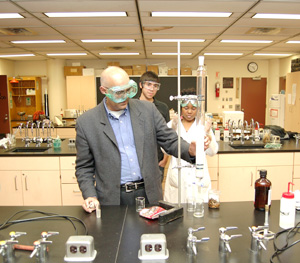
Growing up in Guyana, Brahmadeo Dewprashad routinely ate foods made from local plants, many of which had medicinal qualities. “Some were stimulants; others killed germs or were otherwise beneficial to health,” he recalls. “Of course, no one knew why they were effective – only that they were.”
These days, Dewprashad, an Associate Professor in BMCC’s Department of Science, is looking for answers. In an ongoing research project, he and several of his organic chemistry students, are analyzing several plants indigenous to the Caribbean, with a view to deconstructing their chemical composition and finding out what it is, exactly, that makes the plants effective.
Secret sauce
A current study is focused on a plant-based sauce, made from the Cassava plant, that is commonly added to food to retard spoilage. “We’re in the early stages of our investigation, but our students have already demonstrated the sauce’s antibacterial properties,” says Dewprashad, who recalls eating the sauce with great pleasure as a child. The next step is to identify, separate and analyze the constituents of the sauce, using high-pressure liquid chromatography instruments – just as food and pharmaceutical companies do with all products in their research-and-development pipeline. “This is a valuable experience for the students, many of whom plan to go on careers in health care and the life sciences – including those who will attend medical school,” Dewprashad says. In addition, work was done in collaboration with Professors Hendrix and Goldberg, now retired, who brought microbiological expertise to the project.
Second-year student Olapeju Olasokan has been studying the effects of a reputed anti-hypertensive extract derived from the Mauby plant. “The idea is to place a drop of the extracted material on a black worm and then observe its affect on the worm’s pulse rate,” she says. “Often, the pulse rate increases too quickly and the eventually worm dies, which indicates that the concentration is too strong. So we go back and prepare a different concentration.”
Olasokan, who plans to study medicine, says her research experience, which draws on her knowledge of biology and organic chemistry, and that makes it especially interesting to her. “As a physician, I think it will be important for me to understand how various medications work and how they affect vital processes,” she says. “That requires a grounding in chemistry as well as biology.”
Interdisciplinary approach
Dewprashad agrees that the interdisciplinary nature of the research is of great value to the students. “Real research almost always draws on the contributions of people from different fields,” he says. “This effort has been helped by faculty from biology and other areas.” Professor Sarah Salm has been particularly helpful to our students and taught them how to observe and measure pulse rate changes in blackworms.
Olasokan’s classmate Thomas Ochoa is likewise analyzing a stimulant medication—one with similarities to prescription drugs used to treat circulatory problems. “The lab work has been a valuable addition to my classroom and textbook studies,” he says. “It’s really opened my eyes to what you need to do to achieve any amount of viable data.”

